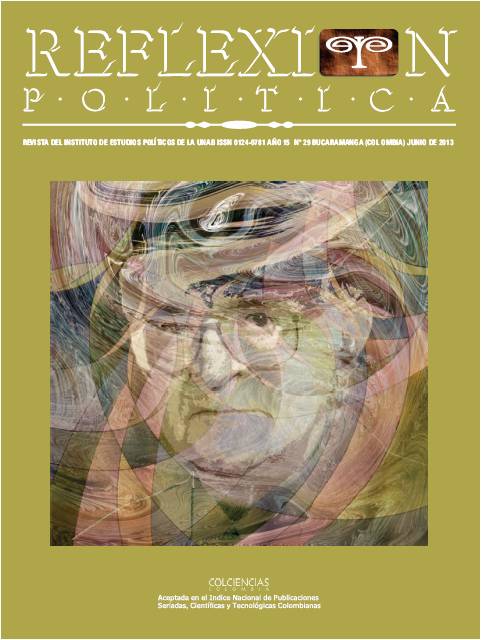La teoría del capital social de Robert Putnam: originalidad y carencias
Resumen
Desde la mitad de los años 1990, una abundante literatura científica se ha desarrollado en torno al concepto de capital social. Existe una pluralidad de perspectivas que declinan esta noción: desde los recursos que un individuo puede movilizar como consecuencia de su pertenencia a un grupo, hasta la reciprocidad, la solidaridad o la confianza entre los miembros de un grupo, pasando por las características institucionales e incluso culturales de una sociedad. En este sentido, el objetivo de este artículo es analizar la originalidad y las carencias de la teoría del capital social de Robert Putnam. Si este autor revela la vinculación empírica de redes y normas, y la influencia tanto del asociacionismo como de la participación cívica en el desarrollo económico y la cohesión social de una sociedad, su teoría se caracteriza por ciertos deslizamientos, la debilidad de su tesis principal, la confusión y circularidad del concepto de capital social, la ambigüedad de su discurso político y su tentación retorica; sin olvidar su uso cuestionable de ciertos indicadores. Putnam intenta responder a estas críticas realizando algunas adecuaciones de su enfoque teórico y, sobre todo, desarrollando una amplia campaña de comunicación para difundir sus ideas y marginar las críticas.
Referencias bibliográficas
Almond, G.A. y Verba, S. The Civic Culture.
Princeton: Princeton University Press, 1963.
Banfield, E.C. The Moral Basis of a Backward Society. Chicago: The Free Press, Glencoe/Research Center in Economic Development and Cultural Change, University of Chicago.
Boix, C. y Posner, D.N. “Making social capital work: a review of Robert Putnam's Making Democracy Work”. Harvard-CFIA Working Paper, n°96-4 (1996).
Bourdieu, P. “Le capital social: notes provisoires”. Actes de la recherches en sciences sociales, n°31 (1980): 2-3.
Coleman, J. Foundations of Social Theory. Cambridge: Belknap Press of Harvard University Press.
Dasgupta, P. “Economic progress and the idea of social capital”, in Dasgupta, P. y Serageldin, I. (dir.). Social Capital: A Multifaceted Perspective. World Bank: Washington, pp.325- 401.
Durlauf, S.N. “The case against social capital”. Focus, vol.20, n°3 (1999): 1-5.
Durlauf, S.N. “Bowling alone: a review essay”. Journal of Economic Behavior and Organization, vol.47, n°3 (2002a): 259-273.
Durlauf, S.N. “On the empirics of social capital”. The Economic Journal, vol.112, n°483 (2002b): 459-479.
Foley, M. y Edwards, B. “Escape from politics? Social theory and the social capital debate”. American Behavioral Scientist, vol.40, n°5 (1997): 550-561.
Friedan, B. The Feminine Mystique. New York: Norton, 1963.
Goldberg, E. “Thinking about how democracy works”. Politics and Society, n°24 (1996): 7-18.
Granovetter, M. Getting a job. A Study of Contacts and Careers. Cambridge: Harvard University Press, 1974.
Jackman, R.W. y Miller, R.A. “A renaissance of political culture?”. American Journal of Political Science, n°40 (1996): 632-669.
Ladd, E.C. “The data just don't show erosion of America's social capital”. The Public Perspective, vol.7, n°1 (1996): 5-22.
Ladd, E.C. “Bowling with Tocqueville: civic engagement and social capital”. American Enterprise for Public Policy Research (September 1998).
Ladd, E.C. The Ladd Report. New York: The Free Press, 1999.
Lemann, N. “Kicking in groups”. The Atlantic Monthly, vol.277, n°4 (1996): 22-26.
Levi, M. “Social and unsocial capital: a review essay of Robert Putnam's Making Democracy Work”. Political and Society, n°24 (1996): 45- 55.
Olson, M. The Logic of Collective Action: Public Goods and the Theory of Groups. Cambridge: Harvard University Press, 1971.
Olson, M. The Rise and Decline of Nations: Economic, Growth, Stagflation and Social Rigidities. New Haven: Yale University Press, 1982.
Minkoff, D.C. “Producing social capital”. American Behavioral Scientist, vol.40, n°5 (1997): 606-619.
Newton, K. “Social capital and democracy”. American Behavioral Scientist, vol.40, n°5 (1997): 575-586.
Paxton, P. “The social capital declining in the United States?”. American Journal of Sociology, n°105 (1999): 88-127.
Portes, A. “Social capital: its origins and applications in modern sociology”. Annual Review of Sociology, n°24 (1998): 1-24.
Portes, A. y Landolt, P. “The downside of social capital”. The American Prospect, vol.7, n°26 (1996).
Po r t e s , A . y S e n s e n b r e n n e r ? J. “Embededness and immigration: notes on the social determinations of economic action”. American Journal of Sociology, vol.98, n°6 (1993): 1320-1350.
Putnam, R. “The prosperous community. Social capital and public life”. The American Prospect, vol.4, n°13 (1993): 35-42.
Putnam, R. “Bowling alone: America's declining social capital”. Journal of Democracy, vol.6, n°1 (1995a): 65-78.
Putnam, R. “Tuning in, tuning out. The strange disappearance of social capital in America”. Political Science and Politics, vol.28 , (1995b): 664-683.
Descargas

Esta obra está bajo una licencia internacional Creative Commons Atribución-NoComercial-SinDerivadas 4.0.
| Estadísticas de artículo | |
|---|---|
| Vistas de resúmenes | |
| Vistas de PDF | |
| Descargas de PDF | |
| Vistas de HTML | |
| Otras vistas | |





















